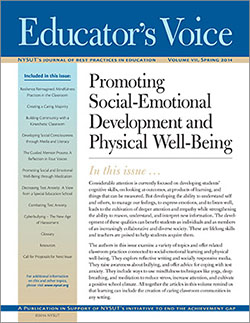As another round of standardized tests in English language arts and math rolls out in April, the stress season for students as young as 8 is a growing concern for educators.
Shannon Miller, school psychologist with the Germantown Teachers Association, says overall student anxiety is on the rise, especially in the wake of new Common Core standards and the high-stakes tests attached to them. Like many other educators and school health care professionals, she is bringing new coping skills to students.
Last year's testing season was marked by widespread reports by teachers and parents of students getting physically sick and emotionally distraught over the standardized tests. It prompted many parents to exercise the option of refusing to let their children take tests.
Students, school psychologists say, are keenly aware of the high stakes attached to state exams. They spend an inordinate amount of class time preparing for them, and know that doing poorly could ultimately cause a school to close or a teacher to lose a job.
Students also can feel pressured by their inner drive to succeed, a quest for perfection or a fear of failure, especially if they may be unfamiliar with the English language or are not yet up to the reading or developmental level of the test in front of them.
Miller tries to give students more tools to combat test stress. For example, she teaches first graders deep breathing to become calm and focus. She hosts small groups of second graders so they can talk about test anxiety.
A workshop on strategies for dealing with test anxiety drew a packed crowd at a recent conference of the New York Association of School Psychologists. Presenters Michelle Storie, a psychologist with the North Syracuse Education Association, and Sara Dool, a psychologist with the United Liverpool Faculty Association, referenced a 2013 study that showed students reported significantly greater levels of test anxiety for the high-stakes exams than for regular classroom tests, in both physiological and cognitive symptoms.
An oft-used practice of pulling individual students out of class to help them deal with stress often increases anxiety because they then miss classroom instruction.
So Storie and Dool started a whole-class stress reduction project in three fourth-grade classrooms. The school psychologists used assessment and test anxiety scales to create a baseline, and then introduced 25 minutes of stress intervention once a week for seven weeks.
Their tools provided the youngsters with general knowledge about test anxiety, relaxation techniques, positive self-talk, note-taking strategies, study skills, test-taking strategies, and review and practice.
Lessons included the fly swatter game (students from different teams swat at words written on the board to find the correct answers to questions, giving them physical activity and energy while finding solutions); progressive muscle relaxation (using an animated video of a turtle); and guided imagery that encourages students to take a journey in their minds, showing how thoughts are related to feelings and can be used to settle down.
The psychologists showed students an animated video introducing deep breathing (long, deep slow breaths vs. short, quick shallow breaths) and simple yoga postures.
Before the intervention, 18 out of 38 fourth graders rated test anxiety levels in the high range. After the seven classroom sessions, only nine out of the 38 fourth graders reported abnormal levels of anxiety.
Phung Tran-Smith, a school psychologist for students ages 6-21 at Monroe #1 BOCES, holds small groups for students to work on behavior modification through visualization. Just as athletes use visualization before a competition, she sees the benefits of letting students use the same tools to help them cope with a big test.
"We talk about why this [test] is important," said Tran-Smith, a member of BOCES United Professionals. "We train the brain to produce thoughts to be powerful."
Tran-Smith attended the session on reducing test anxiety "to get evidence for teachers" (already pressed for class time) that whole class techniques work. Getting an entire school on board, along with the students' parents, can have a wider impact on reducing test anxiety.
The techniques of mindfulness can help calm students who are already stressed in other ways, some by a tough economy that can affect their housing or food.
"When a child is under stress it disrupts the working memory," said South Glens Falls middle school teacher Jon Larson. "If parents have a hard time dealing with stress it manifests in a lot of ways."
Additionally, he said, with the introduction of Common Core testing, "more students are struggling with test anxiety and, it seems, math."
Students "take so many" tests that anxiety rises. "I see it as a prevalent issue and I'm concerned it's becoming worse," Larson said.
And, under Gov. Cuomo's current budget proposals, test stress would only grow worse. Cuomo wants to more than double the weight — from 20 percent to 50 percent — of standardized test scores to evaluate teachers.
That would foist a lot more unnecessary and unwarranted pressure on students who already feel anxious.
 RESOURCES TO COMBAT TEST STRESS
RESOURCES TO COMBAT TEST STRESS
- Educators can find solid information for helping with test anxiety by using a toolkit prepared for the New York Association of School Psychologists at www.nyasp.biz/pdf_files/testing_anxiety_toolkit.pdf. PowerPoint presentations from many of the conference workshops are available, courtesy of NYASP, at www.nyasp.biz. The link includes the PowerPoint for test anxiety.